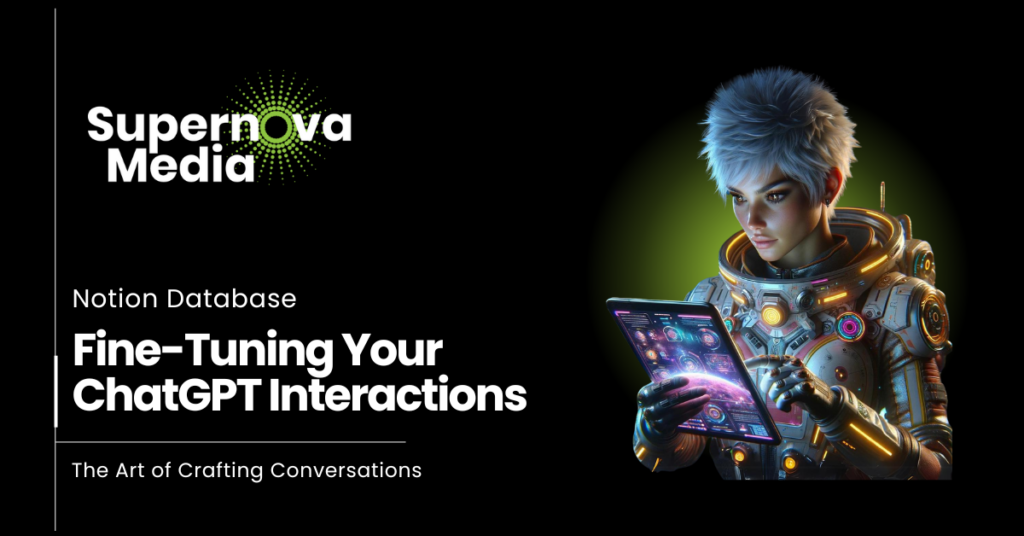|
Getting your Trinity Audio player ready...
|

The Art of Crafting Conversations
Hey there, AI enthusiasts! 🌟
You’re already equipped with prompting best practices and today, we’re diving headfirst into the exciting world of ChatGPT interactions. Picture this: You’ve got the keys to a powerful car — ChatGPT. But how do you drive it to its fullest potential? Let’s shift gears and get you cruising down the highway of prompt perfection.
Ever heard the saying, “It’s not what you say, but how you say it”? Well, when it comes to ChatGPT, it’s both! Your prompts are the roadmap — they guide ChatGPT on what to generate and how to steer the conversation. Be clear, be specific, and, most importantly, be intentional. (Hint: Don’t be shy; detail is your friend!)
The Basics: Prompt Precision
Understanding the Importance of Precision
Your journey with ChatGPT begins with the art of precision in your prompts. Each word you choose is a building block, shaping the responses you receive.
- Example 1: Broad vs. Specific Prompts Broad Prompt: “Write about technology.” Specific Prompt: “Write a 500-word article on the impact of blockchain technology on supply chain management, focusing on transparency and security aspects.”
Action Steps:
- Identify your objective clearly before crafting your prompt.
- Use specific details like topic, word count, and key points you want covered.
Zero to Hero: Few-Shot Learning
Leveraging Few-Shot Learning for Better Outcomes
Few-shot learning is like guiding a friend with examples rather than instructions. By providing ChatGPT with context through examples, you enhance its understanding and the relevance of its outputs.
- Example 2: Improving Response Accuracy Before: “How do I start a blog?” After Few-Shot Learning: “Imagine I’m a first-time blogger interested in sustainability. What are the first three steps I should take to start my blog, and what unique angle can I explore within sustainability?”
Action Steps:
- Gather a few examples that closely match the output you’re looking for.
- Integrate these examples into your prompt as a guide for ChatGPT.
Fine-Tuning in Action
Crafting Effective Prompts with Detailed Examples
Let’s apply what we’ve learned to draft prompts that return detailed, nuanced responses.
- Example 3: Detailed Prompt Crafting Objective: Create engaging social media content. Prompt: “Generate a week’s worth of engaging social media posts for a brand that sells eco-friendly kitchen products. Each post should highlight a product benefit, include a call-to-action encouraging sustainable living, and suggest an accompanying image theme.”
Action Steps:
- Break down your objective into specific, actionable components.
- Construct a prompt that incorporates these components, ensuring clarity and detail.
Getting the Tone Just Right
Matching Tone to Intention
The tone of your ChatGPT-generated content should reflect your brand’s voice or the intended mood of the communication.
- Example 4: Setting the Tone Objective: Write an informative yet friendly email to subscribers. Prompt: “Write a 300-word email to our subscribers introducing our new line of eco-friendly kitchen products. The tone should be informative, enthusiastic, and friendly, inviting readers to explore the benefits and impact of sustainable living.”
Action Steps:
- Clearly define the tone before crafting your prompt.
- Use adjectives to describe the desired tone within the prompt itself.
Vocabulary: Keeping It Real
Choosing the Right Words
The vocabulary you select can make your content relatable or alienate your audience. Clarity and accessibility should be the goal.
- Example 5: Vocabulary Selection Objective: Explain a complex topic in simple terms. Prompt: “Explain blockchain technology in simple terms, suitable for readers with no prior knowledge of blockchain. Use analogies and avoid technical jargon.”
Action Steps:
- Consider your audience’s knowledge level.
- Choose words and phrases that are easy to understand.
The Rhythm of Writing
Crafting Readable, Engaging Content
The structure of your writing—its rhythm, paragraph length, and use of stylistic devices—plays a crucial role in keeping readers engaged.
- Example 6: Structuring Content Objective: Write a compelling, easy-to-read blog post. Prompt: “Write a 1000-word blog post on the benefits of meditation for mental health. Structure the post with short paragraphs, include bullet points for key benefits, and use engaging questions to involve the reader.”
Action Steps:
- Define the structure and style upfront in your prompt.
- Use directives on paragraph length, bullet points, and questions to guide the structure.
Conclusion
Congratulations! You’re ready to fine-tune your ChatGPT interactions like a pro. Remember, the journey to mastery is ongoing. Experiment, refine, and don’t be afraid to get creative with your prompts.
Remember the Prompt Library we shared in lesson one? It’s the perfect place to keep those prompts at your fingertips. Whether you’ve crafted a prompt that flawlessly captures the tone you’re aiming for, or you’ve honed a few-shot learning example that hits the mark every time, don’t let them go to waste.
As you continue on your learning journey, remember that every prompt is an opportunity to learn and improve. Embrace the process, and soon you’ll find that ChatGPT isn’t just a tool—it’s your new teammate ready to assist.
Until next time, keep prompting, keep fine-tuning, and let’s keep this conversation about the endless possibilities with AI going. The future is bright, and it’s ours to write.
Happy prompting!

















